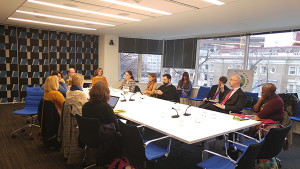Unprecedented database of electoral violence could result in safer elections
By Jillian SlutzkerFebruary 10, 2016
Groundbreaking research analyzing more than two decades of electoral violence will generate insights that could lead to safer elections—as well as surprises about perpetrators of malfeasance.
The Explaining and Mitigating Electoral Violence project, which is implemented jointly by the University of Glasgow and Creative Associates International, will deliver new tools and research to support electoral management bodies and development practitioners in keeping elections secure.
Sarah Birch, Ph.D., of the University of Glasgow, unveiled early findings from the three-year research project on electoral violence, which is building the world’s largest electoral violence database to date.
“The main impetus for doing this research was to help people like you better do what you do to detect and prevent electoral violence,” Birch told a group of electoral security practitioners at the launch of a new Electoral Violence Affinity Group on Feb. 4 at the Alliance for Peacebuilding in Washington, D.C.
With a team of researchers and computer scientists, Birch and Jeff Fischer, Creative’s Senior Electoral Advisor, are currently developing two datasets: a macro-level dataset examining elections worldwide from 1995 to 2015; and a micro-level dataset cataloguing specific incidents of electoral violence since 2009, through data mining of social media and online news reports.
The incident-level dataset will ultimately result in a real-time tool for observers and electoral management bodies to monitor and forecast incidents of electoral violence, and then plan prevention and mitigation activities accordingly.
Authorities more likely to be perpetrators

To date, Birch and her team have completed their macro level data set for elections in Africa from 1995 to 2014.
The research shows that state actors have been the biggest perpetrators of electoral malfeasance and violence on the continent, explained Birch, but this largely consists of threats rather than actual assaults. While non-state actors are less likely to commit such acts, their actions are more likely to be violent.
The findings also reveal a U-shaped relationship between the state’s concentration of power and the likelihood of electoral violence.
“At one end of the spectrum you have state failure,” said Birch. “At the other extreme you have an authoritarian state where violence is concentrated in the hands of a few people and people don’t really participate in any legitimate decision making.”
The data also revealed an inverse correlation between economic development and levels of electoral violence, as well as an increase in the chances of electoral violence following a recent regime change.
For actors wishing to influence the system, “instability equals opportunity,” said Birch.
Call for input from electoral assistance providers
Birch issued a call for electoral security practitioners to submit electoral assistance project documents to the Explaining and Mitigating Electoral Violence project for research on best practices in prevention.
“This would be very useful for us because we can use it to extract from that who’s been doing electoral violence prevention work in the field and link that up to our datasets.”
By running analysis of the types of interventions, randomized, and coded to protect the identity of implementers, overlaid with the macro-level and incident-level datasets on electoral violence, Birch and her team seek to gauge what types of interventions have contributed to mitigating or preventing electoral violence.
She wants to find out “what works, where, under what conditions and why?” with the goal of keeping more elections secure in the future.
“The reason we’re doing this project is that we want to have an impact….We want to link up with people who will be able to benefit from the data analysis…and [use] the methods in field.”
New affinity group launched

Birch announced preliminary findings of the study on Explaining and Mitigating Electoral Violence during the inaugural meeting of Alliance for Peacebuilding’s new Electoral Violence Affinity Group, co-convened with Creative, which will share resources and lessons learned in the field.
“There is a community out there doing electoral violence prevention, but there really isn’t a mechanism for us to communicate and coordinate,” said Creative’s Jeff Fischer.
The group will facilitate collaboration among practitioners working across countries and regions so that electoral violence prevention work in Latin America, for example, can benefit from best practices or successful approaches in Africa or other regions.
Group members also emphasized the importance of thinking “significantly down the line” at the forecast for potential electoral violence years ahead and what preventative actions could be taken now.
To learn more about the Explaining and Mitigating Electoral Violence Project or to read the blog, visit: http://www.electoralviolenceproject.com/
To join Alliance for Peacebuilding’s Electoral Violence Affinity Group, visit: https://alliancepeacebuilding.z2systems.com/np/clients/alliancepeacebuilding/subscribe.jsp?subscription=163&

